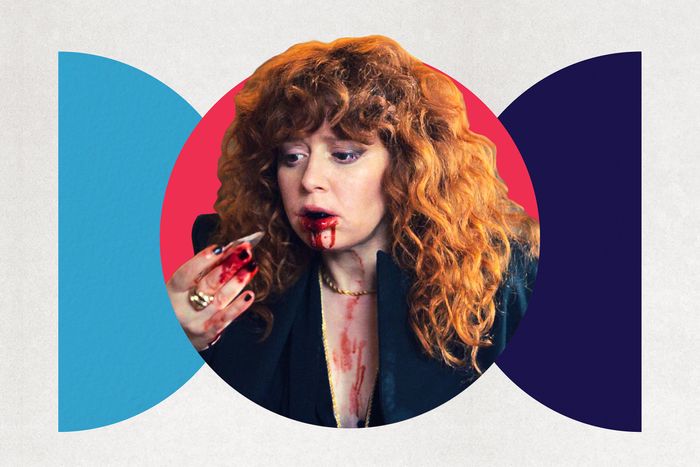
Before helping to shape the darkly existential Netflix comedy Russian Doll, Leslye Headland was no stranger to world building. She wrote seven plays, each based on one of the seven deadly sins. She wrote and directed films including Bachelorette and Sleeping With Other People, which showed off her comic rhythms and her way with actors including Jason Sudeikis and Alison Brie. But Russian Doll, created alongside Amy Poehler and Natasha Lyonne, is by far Headland’s most intricate, elegant, and funniest framework yet. While its Groundhog Day–like premise presents its own stringent logic and rules, the show plays games with death — in one moment, making protagonist Nadia’s demises harrowing and inescapable, and in the next, silly and nonsensical.
In this episode of Good One, Vulture’s podcast about jokes and the people who tell them, Headland — Russian Doll’s co-creator, writer, director, and showrunner — talks about the process of turning her protagonist’s deaths into comedy, one by one. Spoilers abound, so at your own risk, read a short excerpt from the conversation or listen below. Download the episode from Apple Podcasts, Spotify, Stitcher, Overcast, or wherever you get your podcasts.
Good One
Subscribe on:
Death No. 1: Nadia sees her cat Oatmeal across the street; she starts crossing the street and gets hit by a car (episode 1).
That first death had to feel visceral and real – both as you were watching it in real time and also to that character. So you had to end the death with Nadia’s face — not moving, not breathing, not blinking — so that you, the audience member, understood, This is not some kind of dreamscape moment. She is dead. It felt important for this one to feel uneventful, meaning this could happen to anybody at any time. I love that her cat just kind of doesn’t care that she was hit. We die, [and] our pets are like, You win some, you lose some. The cat was just supposed to sit there, but of course, he’s a cat and was like, I’m going to fuck off and go into the park. I just thought, What a cool moment of the world not caring.
Death No. 3: She’s on a phone call with her sometime-boyfriend John, and she falls down a cellar door; her phone bounces down the stairs (episode 2).
I’m so glad you noticed that. It was just something that happened with the stunt double! We had playback on that day because it was a stunt, and I was like, “Is that her phone? Can we bump that up somehow?” When we screened the first three episodes for the premiere, when Nadia came back into the bathroom, this death got the hugest round of applause. People just weren’t expecting it. The show kind of lulls you into this place of like, Maybe she won’t die. And she’s moved into the next day, which is not the rules of Groundhog Day. They just felt like, Oh, you tricked us. This is what the show is about. That kind of mirrors, for me, the kind of existential dread of, Oh right, I forgot, I’m going to die. None of this is worth it.
Deaths Nos. 5-8: Nadia vs. the stairs (episode 2).
We called this “the Frogger Death.” That was one of those logic-versus-tone things that we were kind of like, “But why is she dying? Does this mean something?” To me, what was important was that death become funny from here on out. Death had to be important in the first episode, but in the next few episodes, there would be a sense of humor about her dying.
Death No. 10: She freezes to death while sleeping in the park with the homeless character, Horse (episode 3).
Because the story is psychologically about [addiction and self-harm], it was important we didn’t actually show that. Nadia’s more like, I’m so tough that nothing can hurt me. And if it does, good for it. So if the cold dead of winter gets me, fine, but I’m not going out on self-poisoning. We did think this scene was a death of despair. She’s just been called “the abyss.” She’s hitting a low point emotionally and psychologically. What we thought was interesting was having her suddenly care about someone else. Suddenly she’d be like, I wonder if that person that I died with was okay. And that was the first time it had occurred to this character at all to think about another person. She has that long funny line like, I need to know whether or not my choices that I’ve made have affected another playable character. Do they just pop up again like an NPC?
Death No. 13: Nadia has a deep conversation with her surrogate mother, Ruth, and when she goes to light the stove, that’s it (episode 5).
Alan [who is also stuck in a time loop] has proposed a thesis, which is We’re being punished. As a person alive in our culture, you know this kind of purgatorial repeating of behavior means you have some sort of moral lesson to learn. This had not occurred to Nadia until that moment, and it’s one of the reasons I love her. I love amoral characters — not immoral characters but characters that are neutral. We’ll see that sink in as they see things. I’m hoping the audience is still open enough that they’re hearing what Ruth is saying and questioning Alan’s thesis. Ruth is saying there is no good and bad; it’s that they both exist at the same time, and we’re both of them at the same time. Ruth tells you everything: If you go to the source of your pain, you’re gonna get some version of the answer you’re looking for. You may not be ready to receive it.
Death No. 16: Alan and Nadia meet up, and Alan proposes that they are dying at the same time. Just then an air conditioner falls on them (episode 5).
And death No. 17: They realize they’re both allergic to bees. Nadia goes, “I guess we run into bees right now.” And then they do (episode 6).
I called them the Looney Tunes deaths in my head. I felt it was time to make death that big cartoon sledgehammer or that anvil from the sky; it was like, We were heading to this place no matter what. We knew this was the broadest comedically we were going to be able to get. It felt fun to indulge it right before things were going to get more emotional.
These deaths imply someone is listening and doing this. Who?
Everyone calls it by a different name. I call it the universe, but I think other people would call it a higher power or a god or whatever it is. But yeah, whatever intelligence is behind this entire thing — which I wouldn’t dare to try to explain because I wouldn’t do that in real life — there is an intelligence, and it’s not an accident that it happens after the morality discussion. Once we’ve established a grayer moral playing field, it becomes, Then what? So many of the bigger existential questions in life are like, But then what happens? It’s basically being like, There is a universe, but that is not going to answer the question. You still have to make choices. If you’re sitting and watching the entire thing in one sitting, I get to go, Okay, do you really want to know what this is about? Because if you don’t, you can just stay here with the bees.
Death No. 18: Nadia tells Ruth to leave and then chokes on a chicken bone (episode 6).
This was an experience [Amy] Poehler actually had. She was eating chicken, and either there were people in her house or someone had just left. If she spoke, she would be able to get help, but she couldn’t because she was choking. She had seen an Oprah show where she knew how to give herself the Heimlich and was able to dislodge it. It was both extremely funny but also harrowing in a way that she really put you in the position of it happening to you or a person you knew, as opposed to “Sad Woman Dies Alone With a Chicken Bone in Her Throat.” I remember thinking, Is there a way we can not just capture the loneliness this type of death signifies but explain how she’s only one piece of knowledge away from helping herself? This may be a character that indeed does not need Alan’s help in most areas of her life, but there is one missing piece for her.
Death No. 22: Nadia confronts her younger self and pulls a shard of mirror out of her mouth (episode 7).
My big goal was to make death scary again for the viewer. Like, death, right. That thing that’s always coming after us. That very intense feeling of powerlessness when we stare it straight in the face. The setup of the show is that this is the child of a very sick person who inherited a lot of that person’s trauma and problems. She has their own problems as well — we’re not blaming her mom for everything — but she doesn’t have a template past her mom’s death. So the second she turns 36, she starts reliving that moment over and over again because she just doesn’t know what her life is like when it surpasses her mom’s. In order to have the courage to move past that moment, she has to go back to who she was when her mom was going through that same thing and say, “That is not your problem, and we’re going to move forward from here.”
Will deaths continue to be a framing device next season?
There are a lot of things in life, not just death. Do you know what I mean? While death is the biggest one, there are a lot of things that are death-adjacent or not even necessarily related to death specifically that an existential-adventure show would be able to partake in or discuss. Does everything go back to death? That depends on your philosophy. I can’t say explicitly whether death ends up being the runner of the series, but one thing I can say is that there was definitely a time in my life where death was hanging over me. I don’t live my life that way anymore. So it would be interesting to explore existential issues where that isn’t hanging over your head.


